MRS/MRSI Reconstruction & Quantification
Oral
Spectroscopy & Non-Proton MR
Monday, 18 June 2018
| S02 |
13:45 - 15:45 |
Moderators: Cristina Cudalbu, Nuno Miguel Pedrosa de Barros |
13:45
|
0157.
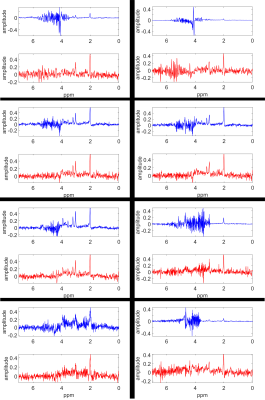 |
 Automatic Removal of Ghosting Artifacts from MR Spectra using Deep Learning Automatic Removal of Ghosting Artifacts from MR Spectra using Deep Learning
Sreenath Pruthviraj Kyathanahally, André Döring, Roland Kreis
Ghosting artifacts in clinical MR spectroscopy are problematic since they superimpose with metabolites and lead to inaccurate quantification. Here, we make use of “Deep Learning” (DL) methods to remove ghosting artifacts in MR spectra of human brain. The DL method was trained on a huge database of simulated spectra with and without ghosting artifacts, which represent complex variants of ghost-ridden spectra, transformed to time-frequency spectrograms. The trained model was tested on simulated and in-vivo spectra. The preliminary results for ghost removal show potential in simulated and in-vivo spectra, but need further refinement and quantitative testing.
|
13:57
|
0158.
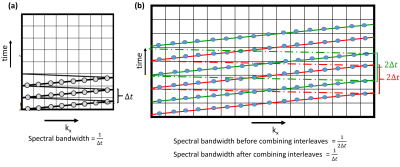 |
 A novel structured low-rank framework for ghost removal and denoising of EPSI data A novel structured low-rank framework for ghost removal and denoising of EPSI data
Ipshita Bhattacharya, Ralph Noeske , Rolf Schulte, Mathews Jacob
Spectral interleaving is often used in echoplanar spectroscopic imaging (EPSI) sequences to achieve high spatial and spectral resolution, especially on high field scanners with larger chemical shift dispersion. Unfortunately, a major roadblock is the spurious Nyquist ghost artifacts, resulting from phase errors between interleaves. We introduce a novel framework, that simultaneously capitalizes on annihilation relation between the interleaves introduced by phase relations, as well as a linear predicability of the spectra, to remove the phase errors and to provide spectral denoising of the spectra. In addition, we also exploit on the low-rank structure of the EPSI data to provide additional spatial denoising, which will further improve the signal to noise ratio of the datasets.
|
14:09
|
0159.
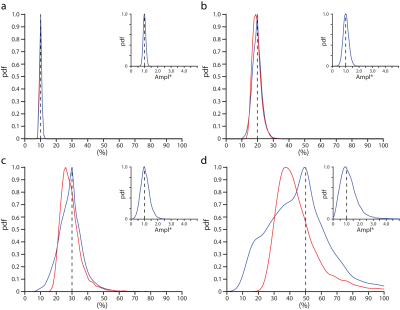 |
 To which extent the Cramér-Rao bound (CRB) is a reliable benchmark in quantitative MRS? To which extent the Cramér-Rao bound (CRB) is a reliable benchmark in quantitative MRS?
Guilhem Pagčs, Jean-Marie Bonny
Following MRS data fitting, absolute or relative Cramér-Rao bounds (CRB and rCRB, respectively) are often computed as indices of parameter uncertainties. However, the unknown true values of parameters are required to compute CRB. Here, we studied the effect of substituting the true values by the noisy estimates on the bounds (noted CRB* and rCRB*). We showed by simulations that both CRB* and rCRB* are particularly sensitive to noise. Also, the mode of rCRB* distribution is left-shifted, which leads to a significant false positive risk when rCRB* is thresholded. A threshold not exceeding 20% is recommended to limit this risk.
|
14:21
 |
0160.
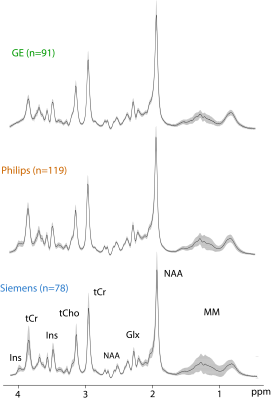 |
 Multi-vendor, multi-site comparison of 1H-MRS PRESS data acquired at 25 research sites Multi-vendor, multi-site comparison of 1H-MRS PRESS data acquired at 25 research sites
Michal Považan, Mark Mikkelsen, Adam Berrington, Peter B. Barker, Pallab K. Bhattacharyya, Maiken K. Brix, Pieter F. Buur, Kim M. Cecil, Kimberly L. Chan, David Y.-T. Chen, Alexander R. Craven, Koen Cuypers, Michael Dacko, Niall W. Duncan, Ulrike Dydak, David A. Edmondson, Gabriele Ende, Lars Ersland, Fei Gao, Ian Greenhouse, Ashley D. Harris, Naying He, Stefanie Heba, Nigel Hoggard, Tun-Wei Hsu, Jacobus F. A. Jansen, Alayar Kangarlu, Thomas Lange, R. Marc Lebel, Yan Li, Chien-Yuan E. Lin, Jy-Kang Liou, Jiing-Feng Lirng, Feng Liu, Ruoyun Ma, Celine Maes, Marta Moreno-Ortega, Scott O. Murray, Sean Noah, Ralph Noeske, Michael D. Noseworthy, Georg Oeltzschner, James J. Prisciandaro, Nicolaas A. J. Puts, Timothy P. L. Roberts, Markus Sack, Napapon Sailasuta, Muhammad G. Saleh, Michael-Paul Schallmo, Nicholas Simard, Stephan P. Swinnen, Martin Tegenthoff, Peter Truong, Guangbin Wang, Iain D. Wilkinson, Hans-Jörg Wittsack, Hongmin Xu, Fuhua Yan, Chencheng Zhang, Vadim Zipunnikov, Helge J. Zöllner, Richard A. E. Edden
In vivo 1H MR spectroscopy (MRS) provides valuable information regarding various brain disorders. In order to enable further clinical acceptance of MRS, this technique needs to be robust across multiple sites and MR vendors. Therefore, we analyzed data from 288 healthy subjects from 25 research sites across the three major vendors and examined vendor-, site- and participant-related effects on metabolites detected by PRESS 1H-MRS at 3T. Within-site and inter-site coefficients of variation were between 2-16%. Significant effects of vendor were found for Ins/tCr and Glx/tCr. Effect of sites contributed ~30% to total variance of all quantified metabolites.
|
14:33
|
0161.
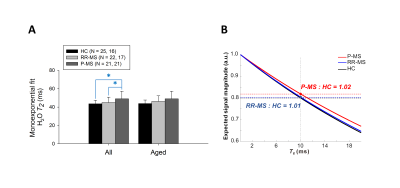 |
 Towards in vivo neurochemical profiling of multiple sclerosis with MR spectroscopy at 7 Tesla: Apparent increase in frontal cortex water T2 in aged patients with progressive multiple sclerosis stabilizes in biexponential model constrained by tissue and CSF partial volumes Towards in vivo neurochemical profiling of multiple sclerosis with MR spectroscopy at 7 Tesla: Apparent increase in frontal cortex water T2 in aged patients with progressive multiple sclerosis stabilizes in biexponential model constrained by tissue and CSF partial volumes
Kelley Swanberg, Hetty Prinsen, Abhinav Kurada, Katherine DeStefano, Mary Bailey, David Pitt, Robert Fulbright, Christoph Juchem
Water is a common internal reference for metabolite quantification by 1H-MRS. We investigate potential influences on water-referenced metabolite quantification by differences in frontal cortex water T2 in individuals with relapsing-remitting, progressive, and no multiple sclerosis. Water T2 differed in monoexponential models, exhibiting highest values in progressive multiple sclerosis only when analyses were not age-controlled. Groupwise T2 did not differ in biexponential models constrained by tissue and CSF partial volumes, suggesting that monoexponential T2 differences reflected disparate proportions of water in tissue and CSF rather than differential behavior within them. Our results suggest stability of water T2 within frontal cortex tissue and CSF with multiple sclerosis and emphasize the superiority of metabolite quantification with group-specific T2 values when voxel composition may differ.
|
14:45
|
0162.
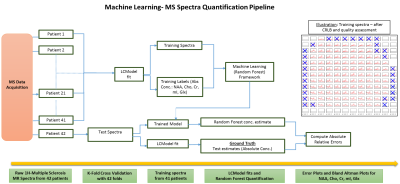 |
 Metabolite Quantification of 1H-MRSI spectra in Multiple Sclerosis: A Machine Learning Approach Metabolite Quantification of 1H-MRSI spectra in Multiple Sclerosis: A Machine Learning Approach
Dhritiman Das, Mike Davies, Jeremy Chataway, Siddharthan Chandran, Bjoern Menze, Ian Marshall
As an alternative to model-based spectral fitting tools, we introduce a machine-learning framework for estimating metabolite concentrations in MR spectra acquired from a homogeneous cohort of 42 patients with Secondary Progressive Multiple Sclerosis. Our framework based on random-forest regression performs a 42-fold cross validation on this dataset which involves (1) learning the spectral features from this cohort; (2) estimating concentrations and calculating relative error over the LCModel estimates. Compared to the LCModel, our method, after training, gives a low estimation error and a 60-fold improvement in estimation speed per patient.
|
14:57
|
0163.
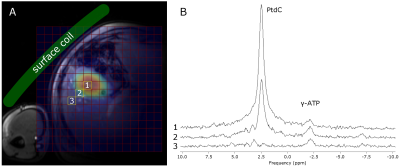 |
 Quantification of Phosphatidylcholine in the gall bladder using 31P MRSI suggest differences in biliary disorders: A Pilot Study. Quantification of Phosphatidylcholine in the gall bladder using 31P MRSI suggest differences in biliary disorders: A Pilot Study.
Lorenz Pfleger, Emina Halilbasic, Martin Gajdošík, Marek Chmelík, Sigfried Trattnig, Michael Trauner, Martin Krššák
This study focuses on quantification of phosphatidylcholine (PtdC) in the gall bladder and investigates concentration differences between biliary pathologies and healthy subjects. Significant different PtdC content was detected in patients suffering from primary sclerosing cholangitis (PSC). Subjects with primary biliary cholangitis (PBC) showed high variances in PtdC concentration. Even though, the PSC and control group are relatively small our results justify for further ongoing studies on this topic.
|
15:09
|
0164.
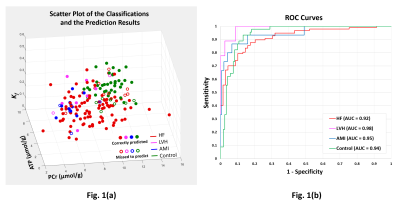 |
 Neural-network discrimination of cardiac disease from 31P MRS measures of myocardial creatine kinase energy metabolism Neural-network discrimination of cardiac disease from 31P MRS measures of myocardial creatine kinase energy metabolism
Meiyappan Solaiyappan, Robert Weiss, Paul Bottomley
Myocardial energy demands are the highest in the body and cardiac metabolism is altered in common diseases. Only phosphorus magnetic resonance spectroscopy (MRS) can measure ATP and creatine-kinase (CK) metabolism, a primary reserve of ATP, noninvasively in the human heart. Here, neural-network analysis is used to test whether the combination of 31P MRS measurements of phosphocreatine and [ATP] concentrations, the CK reaction-rate and its ATP flux, can discriminate cardiac diseases among prior study data from 178 subjects. We find that a three-layer neural-network adequately discriminates diseases without over-training, suggesting that heretofore unidentified differences in CK metabolism may underlie cardiac disease.
|
15:21
 |
0165.
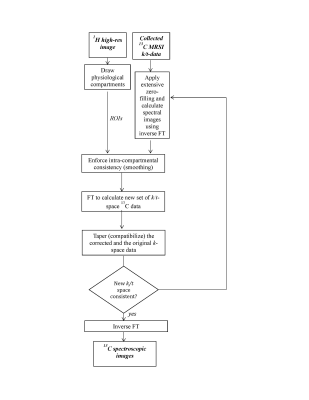 |
 Enhancing In Vivo Hyperpolarized 13C Chemical Shift Imaging by an Iterative Reconstruction Enhancing In Vivo Hyperpolarized 13C Chemical Shift Imaging by an Iterative Reconstruction
Gil Farkash, Stefan Markovic , Lucio Frydman
Hyperpolarized 13C magnetic resonance spectroscopic imaging (MRSI) is a powerful metabolic technique, but it’s challenged by a rapid and irreversible decay of the signal that usually compromises its achievable spatial resolution. In this work we explore a way to improve this by utilizing a priori anatomical information derived from 1H MRI. Enhanced HP-MRSI implementations based on Spectroscopy with Linear Algebraic Modeling (SLAM) were thus assayed, to enhance HP-MRSI’s spatial resolution without compromising SNR. 13C experiments were performed in-vivo and pyruvate/lactate images reconstructed for physiological compartments by SLAM; we compare these results to those arising by traditional Fourier analyses.
|
15:33
 |
0166.
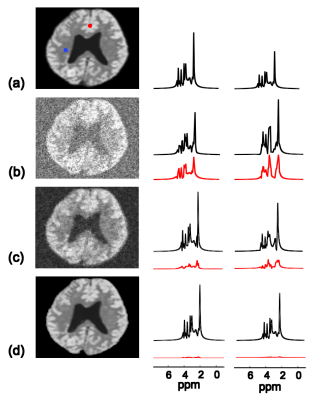 |
 Constrained MRSI Reconstruction Using Water Side Information with a Kernel-Based Method Constrained MRSI Reconstruction Using Water Side Information with a Kernel-Based Method
Yudu Li, Fan Lam, Bryan Clifford, Rong Guo, Xi Peng, Zhi-Pei Liang
Reconstruction for MR spectroscopic imaging (MRSI) is a challenging problem where incorporation of spatiospectral prior information is often necessary. While spectral constraints have been effectively utilized in the form of temporal basis functions, spatial constraints are often imposed using spatial regularization. In this work, we present a new kernel-based method to incorporate a priori spatial information, which was motivated by the success of kernel-based methods in machine learning. It provides a new mechanism for constrained image reconstruction, effectively incorporating a priori spatial information. The proposed method has been evaluated using both simulation and in vivo data, producing very impressive results. This new reconstruction scheme can be used to process any MRSI data, especially those from high-resolution MRSI experiments.
|
|












